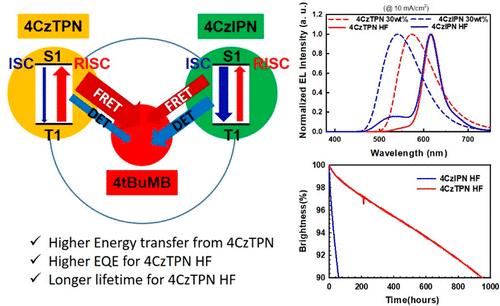当前位置:
X-MOL 学术
›
ACS Appl. Mater. Interfaces
›
论文详情
Our official English website, www.x-mol.net, welcomes your
feedback! (Note: you will need to create a separate account there.)
A New BODIPY Material for Pure Color and Long Lifetime Red Hyperfluorescence Organic Light-Emitting Diode
ACS Applied Materials & Interfaces ( IF 8.3 ) Pub Date : 2021-04-07 , DOI: 10.1021/acsami.1c03175 Young Hun Jung 1 , Durai Karthik 1 , Hyuna Lee 1 , Jee Hyun Maeng 1 , Ki Joon Yang 1 , Soonjae Hwang 1 , Jang Hyuk Kwon 1
ACS Applied Materials & Interfaces ( IF 8.3 ) Pub Date : 2021-04-07 , DOI: 10.1021/acsami.1c03175 Young Hun Jung 1 , Durai Karthik 1 , Hyuna Lee 1 , Jee Hyun Maeng 1 , Ki Joon Yang 1 , Soonjae Hwang 1 , Jang Hyuk Kwon 1
Affiliation

|
A red fluorescent material, 1,3,7,9-tetrakis(4-(tert-butyl)phenyl)-5,5-difluoro-10-(2-methoxyphenyl)-5H-4l4,5l4-dipyrrolo[1,2-c:2′,1′-f][1,3,2]diazaborinine (4tBuMB), as an emitting dopant in a thermally activated delayed fluorescence (TADF) sensitized hyperfluorescence organic light-emitting diode (HFOLED) is reported. The 4tBuMB shows a high photoluminescence quantum yield (PLQY) of 99% with an emission maximum at 620 nm and a full width at half-maximum (fwhm) of 31 nm in solution. Further, it shows a deep lowest unoccupied molecular orbital (LUMO) of 3.83 eV. Thus, two TADF materials, 4CzIPN and 4CzTPN, as sensitizing hosts, are selected on the basis of a suitable LUMO level and spectrum overlap with 4tBuMB. The fabricated HFOLED device with 4CzTPN as a sensitizing host and 4tBuMB as an emitting dopant shows a maximum external quantum efficiency (EQE), an emission maximum, an fwhm, and CIE coordinates of 19.4%, 617 nm, 44 nm, and (0.64, 0.36), respectively. The electroluminance performances of the 4CzTPN sensitized device are higher than those of the 4CzIPN-based device, which is attributed to a higher Förster resonance energy transfer (FRET) rate and reduced intersystem crossing/reverse intersystem crossing (ISC/RISC) cycles of the former. Also, the 4CzTPN-based HF device shows a longer device lifetime (LT90) of 954 h than the 4CzIPN-baed device (LT90 of 57 h) at 3000 cd m–2. The higher device stability is due to the higher bond dissociation energies (BDEs) of 4CzTPN and 4tBuMB than that of 4CzIPN.
中文翻译:

一种用于纯色和使用寿命长的红色超荧光有机发光二极管的新型BODIPY材料
红色荧光物质1,3,7,9-四(4-(叔丁基)苯基)-5,5-二氟-10-(2-甲氧基苯基)-5 H -4l4,5l4-dipyrrolo [1, 2- c:2′,1′- f据报道,在热活化延迟荧光(TADF)敏化的超荧光有机发光二极管(HFOLED)中,作为发光掺杂剂的[] [1,3,2]二氮硼硼烷(4tBuMB)。4tBuMB在溶液中显示出99%的高光致发光量子产率(PLQY),最大发射在620 nm处,半峰全宽(fwhm)为31 nm。此外,它显示出3.83 eV的深最低的未占据分子轨道(LUMO)。因此,基于合适的LUMO能级和与4tBuMB重叠的光谱,选择了两种TADF材料4CzIPN和4CzTPN作为敏化基质。以4CzTPN作为增感主体,4tBuMB作为发射掺杂剂的HFOLED器件显示出最大外部量子效率(EQE),发射最大值,fwhm和CIE坐标分别为19.4%,617 nm,44 nm和(0.64, 0.36)。4CzTPN敏化器件的电致发光性能高于基于4CzIPN的器件,这归因于前者的较高的Förster共振能量转移(FRET)速率和减少的系统间交叉/反向系统间交叉(ISC / RISC)周期。此外,基于4CzTPN的HF设备显示出更长的设备寿命(LT在3,000 cd m –2的情况下比4CzIPN接入的设备(90小时的LT 90)要好954 h的90)。更高的器件稳定性是由于4CzTPN和4tBuMB的键离解能(BDE)比4CzIPN的键离解能更高。
更新日期:2021-04-21
中文翻译:

一种用于纯色和使用寿命长的红色超荧光有机发光二极管的新型BODIPY材料
红色荧光物质1,3,7,9-四(4-(叔丁基)苯基)-5,5-二氟-10-(2-甲氧基苯基)-5 H -4l4,5l4-dipyrrolo [1, 2- c:2′,1′- f据报道,在热活化延迟荧光(TADF)敏化的超荧光有机发光二极管(HFOLED)中,作为发光掺杂剂的[] [1,3,2]二氮硼硼烷(4tBuMB)。4tBuMB在溶液中显示出99%的高光致发光量子产率(PLQY),最大发射在620 nm处,半峰全宽(fwhm)为31 nm。此外,它显示出3.83 eV的深最低的未占据分子轨道(LUMO)。因此,基于合适的LUMO能级和与4tBuMB重叠的光谱,选择了两种TADF材料4CzIPN和4CzTPN作为敏化基质。以4CzTPN作为增感主体,4tBuMB作为发射掺杂剂的HFOLED器件显示出最大外部量子效率(EQE),发射最大值,fwhm和CIE坐标分别为19.4%,617 nm,44 nm和(0.64, 0.36)。4CzTPN敏化器件的电致发光性能高于基于4CzIPN的器件,这归因于前者的较高的Förster共振能量转移(FRET)速率和减少的系统间交叉/反向系统间交叉(ISC / RISC)周期。此外,基于4CzTPN的HF设备显示出更长的设备寿命(LT在3,000 cd m –2的情况下比4CzIPN接入的设备(90小时的LT 90)要好954 h的90)。更高的器件稳定性是由于4CzTPN和4tBuMB的键离解能(BDE)比4CzIPN的键离解能更高。































 京公网安备 11010802027423号
京公网安备 11010802027423号